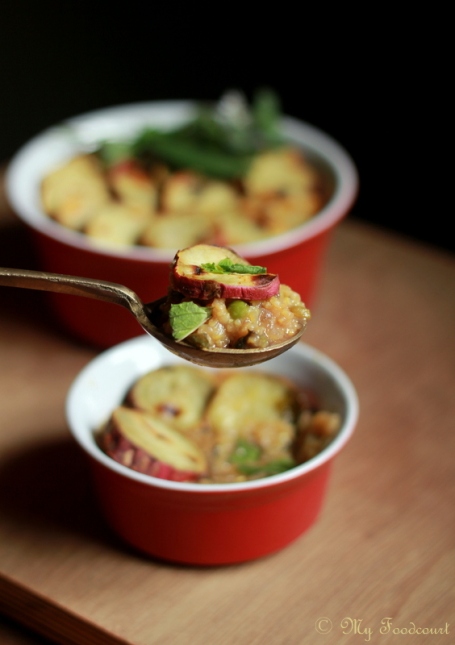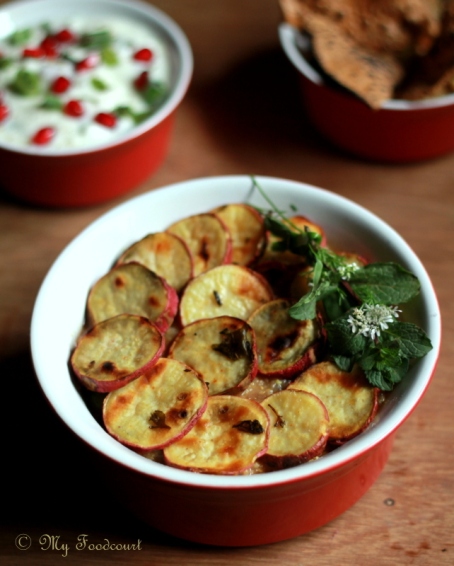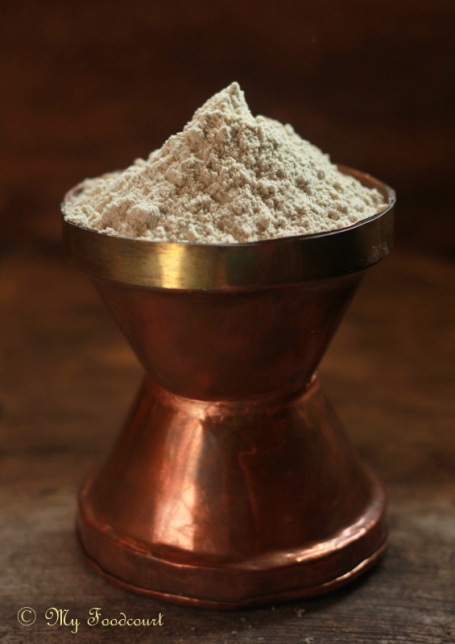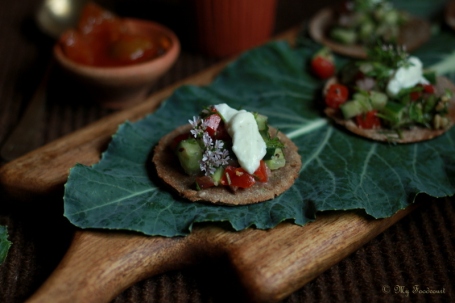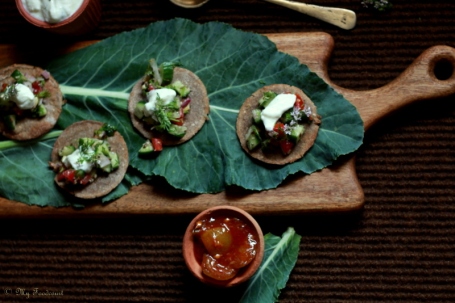Posts filed under ‘mustard seed’
Rajasthani Papad Mangodi ki Kadhi for Regional Indian Home cooking
Happy New Year to all the readers of My Foodcourt!

After all the festive binge eating, it is time now to get back to simple hearty meals. My friend Garima has a recipe for a comforting Rajastahni Papad Mangodi ki Kadhi, perfect for the nippy weather.
I met Garima when she was staying in Nasik. I was thrilled to discover another food blogger from Nasik! But by the time we actually met, sadly it was time for her to move to Bombay. We met just for a couple of hours and we connected instantly. I felt like we have known each other forever! She has some fabulous Rajasthani recipes on her blog Café Garima and I have bookmarked many of them.
Here’s Garima with her authentic Rajasthani Papad Mangodi ki Kadhi for my series on Regional Indian Home cooking.
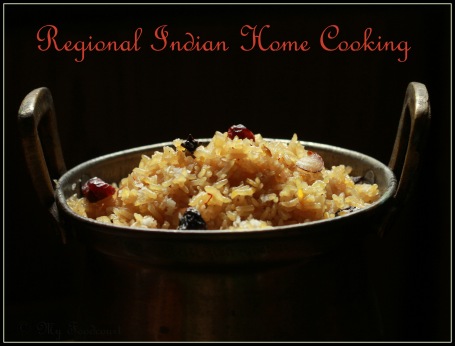
Hello! I am Garima and blog at Café Garima. I am delighted to be doing a regional guest post for Madhuli at her lovely blog ‘My Foodcourt’. A great admirer of Madhuli’s gorgeous pictures and unusual recipes, I am fortunate enough to have met her and cherish the beautiful couple of hours we spent together.
It is indeed, a pleasure to be here. Thanks for having me over Madhuli!
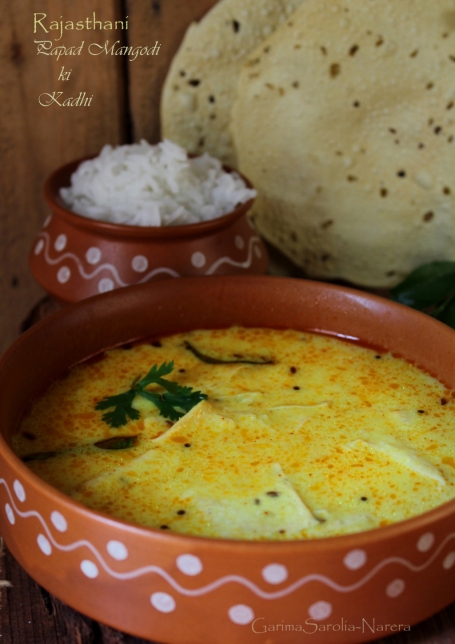
I present a traditional recipe from Rajasthan, Papad Mangodi ki Kadhi. I have fond childhood memories of Ma extracting butter from malai (cream) collected over a fortnight from atop the milk. Kadhi was then made from the buttermilk, which was left behind after having extracted the butter. It is a tradition I have carried on in my household.

Kadhi made from fresh buttermilk has a lovely earthy flavour. Moong dal nuggets or mangodis are added to the buttermilk curry as it cooks and roasted papads/poppadums are added at the end. A tempering of asafoetida and mustard seeds completes this very Rajasthani delight, very apt for a winter afternoon. Here is how I make it.
Papd Mangodi Kadhi Recipe
(Serves 4)
Ingredients
For the Kadhi
3 cups of buttermilk/ 1 cup of curd + 2 cups of water, beaten till smooth
2 Tbsp besan/gram flour
1 tsp salt
¼ tsp haldi/ turmeric powder
¼ cup mangodi
2-3 papads
For the tempering
1 Tbsp ghee
4-5 curry leaves
1 tsp rai/mustard seeds
¼ tsp jeera/cumin seeds
½ tsp red chilli powder
Method
Before you begin making the Kadhi, ensure that the buttermilk is at room temperature.
In a heavy bottomed vessel/kadhai add the salt and turmeric to the buttermilk and mix well, ensuring there are no lumps. Bring this mixture to a boil stirring continuously. Once the mixture has reached a rolling boil, reduce the heat and cook covered for 25 minutes. Keep adding water in case the mixture gets too thick. About 20 minutes into the cooking time, add the mangodi and half a cup of water. Cook till mangodi is done. Take off the flame. Break the roasted papads into large pieces and add to the kadhi.
To temper, heat ghee and add asafoetida, mustard seeds and cumin to it. Once the mustard begins to crackle, take off the heat and add curry leaves and red chilli powder. Spread over the Kadhi. Serve hot over rice or will chapatti.

Desi Health Bites – Mini Thalipeeth Tostadas
I love experimenting with different grains and flours. Jowar, Nagli/Ragi,Amaranth, Corn etc.. are pantry staples in my house. Most of the times,I use a blend of these grains for our day-to-day food in the form of khichdis, upmas,dosas.
One such multipurpose, wholesome flour mix is the ‘Thalipeeth Bhajani. This is a pantry staple in every Maharashtrian household.
Bhajani Thalipeeth basically is a quick flat bread made using this multigrain Bhajani mix along with chopped onions,sometimes some chopped fresh or leftover vegetables, fresh coriander, sesame seeds and spices.It is usually served for breakfast with fresh homemade Curd/Yogurt, homemade white butter and/or sweet lime pickle.
My Mom makes her own Thalipeeth Bhajani by roasting – Jowar, Bajra, wheat, Nagli,Rice,Gram dal,Urad dal and cumene , coriander seeds and then milling them together. Needless to say I get my Thalipeeth Bhajani mix readymade from her as and when I am out of stock :). Most supermarkets, grocery stores, health food shops now stock Thalipeeth flour, so it is easily available or see the Quick Mix version given below.
Another favourite item from the Maharashtrian cuisine is ‘Khamang Kakdi’ – cucumber salad tempered with spices and topped with crushed peanuts. I love to add Tomatoes and onion to my Khamang Kakdi.
Both these Classic Maharashtrian favourites, I have combined in a quick modern Appetizer Avatar- Mini Thalipeeth Tostadas, akin to the Mexican Tostadas.
It seems to be a long winded recipe but it uses simple day-to-day ingredients found in most Indian kitchens.With some advance preparation it can be easily put together in under 30 minutes.
I have used Fortune Rice Bran Health Oil for making my Mini Thalipeeth Tostadas.
“Fortune rice bran health oil has a key micronutrient called “oryzanol”, an antioxidant found only in the bran of rice. It helps reduce bad cholesterol,increase good cholesterol and keeps your heart healthy, making it a healthier choice.
Squalene is an organic compound naturally produced by human skin cells and is a natural moisturizer. Fortune Rice Bran Health Oil contains good amounts of it which prevent the ageing of skin.
Antioxidants improve health by fighting free radicals that harm the immune system. Fortune Rice Bran Health oil has natural antioxidants that help build strong immunity”.
“It is a myth that colourless or transparent oils are healthier than dark oils. FRBH is refined optimally to keep all the essential micronutrients intact. It has a darker appearance primarily due to Oryzanol.
It is enriched with a gamut of nutrients and is good for heart, immunity, skin and hormones. It is appropriate for people of all ages”
 Here’s the recipe for my Mini Thalipeeth Tostadas
Here’s the recipe for my Mini Thalipeeth Tostadas
Mini Thalipeeth Tostadas
Makes about 18-19, 3” round Tostadas
Prep time: 20 mins
Cooking time: ~30 mins including baking time
Ingredients
For the Tostados
2 Cups Thalipeeth flour/Multigrain flour *
1 tsp Ajwain/Carom seeds
2 tsp Sesame seeds
½ tsp Dry red chilli powder (or to taste)
2 tsp Fortune Rice Bran Health Oil
2 Tbsp chopped fresh coriander leaves
¼ tsp garlic paste
½ tsp Asafoetida/hing
Warm water as required (~ ¾-1 cup)
For the topping
1 large cucumber peeled finely chopped
1 large Tomato ,seeds removed & finely chopped
½ onion finely chopped
3 tsp roasted peanuts crushed
2 tsp chopped fresh coriander leaves
½ tsp brown sugar
Salt to taste
For tempering
2 tsp Fortune Rice Bran Health Oil
½ tsp mustard seeds
½ tsp Cumene seeds
5-6 Curry leaves
½ tsp powdered Asafoetida
1-2 green chillies chopped
For the herbed Yogurt/Curd
¾ cup thick Yogurt/curd
2 tsp chopped mint leaves
2 tsp chopped coriander leaves
Rock salt to taste
Method
For the Tostados
Preheat the oven to 170 deg C.
Line a baking sheet with Parchment paper.
Add the flour or flours to a mixing bowl.
Add all the other ingredients except the water.Mix well.
Slowly add the warm water and knead the flours into a stiff but pliable dough.
Transfer the dough to a lightly floured work surface.
Roll out into a thin layer. The layer should be as thin as possible while still workable.
Cut rounds using a 3” cookie cutter/ sharp edge of a small steel Dabba.
Transfer to the prepared baking sheet and bake till they turn golden around the edges – ~15-20 minutes. (Keep an eye on them after about 12 minutes as they burn easily.)
Cool completely on a wire rack.
Note: These can be made well in advance. Can be stored in an air tight container for about 2 weeks.
For the topping-Koshimbir
Mix the cucumber, tomatoes, onions in a bowl.
Add the crushed peanuts, salt,sugar and mix
In a small Kadhai/pan add the oil.
Once hot, add the mustard seeds.
Once the mustard seeds crackle, add the cumene seeds, Asafoetida, curry leaves and green chillies.
Pour this over the Cucumber-tomato-onion mixture in the bowl.
Add the chopped coriander and mix again.
Note: The veggies can be chopped in advance but mix everything just before serving and use immediately
For the Herbed Yogurt/Curd
In a small bowl mix together the Yogurt and the herbs.
Season with Rock salt and mix well.
To Assemble the Mini Thalipeeth Tostadas
Keep the crispy Thalipeeth Tostadas on a large serving plate.
Add 1½- 2 spoonfuls of the Koshimbir Topping.
Top with a dollop of the herbed Yogurt
Serve immediately
Other serving suggestions:
You can use Sweet Lime pickle along with the juice, or a coriander-mint chutney or the Marathi Red/Green Chilly Thecha instead of the herbed Yogurt
*Make your own multigrain Quick Thalipeeth flour mix: ½ cup Wheat flour+ ¼ cup Rice flour+ ¼ cup Ragi/Nagli flour+ ¼ cup Jowar flour+1/4 cup Bajra flour+ ¼ Besan/chickpea/Gram flour+ ¼ cup Urad Dal/Black lentil flour + ½ tsp roasted cumene powder+ ½ tsp coriander seed powder
This blogpost is in association with Fortune Foods as a part of their Desi Health Bites activity– The Hunt for the Best Rice Bran Oil Recipes. For more updates and healthy recipes using Fortune Rice Bran Health Oil, follow Fortune Foods on Facebook and on Twitter at @fortunefoods
Ambe Dal
The Mango Mania refuses to leave us. First the tangy green raw mangoes and now the luscious ripe ones. I am still hooked on to the raw mangoes and have been using them in every way I can.
Ambe Dal is a traditional Maharashtrian preparation, specially made during these hot summer days when green Mangoes are abundant. It’s super quick and easy to make (with the exception that you need to soak the dal in advance) and requires just a few easily available ingredients.
The tart raw mangoes are grated and added to coarsely ground soaked chana dal (split Bengal gram). This mixture is then flavoured with a spicy tadka (tempering) of Red chillies, curry leaves and asafoetida . I personally love the flavor of asafoetida .
This cool,tangy-spicy Ambe Dal is served on a banana leaf along with Aam Panha (recipe here)
Here’s the recipe for Ambe Dal
Ingredients
1 cup Chana dal (split Bengal gram) soaked in water for 5-6 hours
½ raw mango, peeled and grated (depending on the tartness the amount can be adjusted)
½ tsp sugar
Salt to taste
For the tadka (tempering)
3tsp oil
½ tsp mustard seeds
½ tsp cumene seeds
5-6 curry leaves
Pinch of asafoetida
1-2 dry Red chillies broken into pieces
Method
Rinse and Drain the soaked Chana dal.
Grind the dal coarsely .
Add the grated mango, salt and sugar .
In a small wok/pan heat the oil.
Add the mustard seeds and once they splutter add the cumene seeds.
Add the curry leaves, asafoetida and the red chillies.
Add this tadka over the Mango Dal mixture and mix nicely .
Cool and serve on a banana leaf along with Aam Panha. I love to ‘cool this dal in the refrigerator for half an hour and then serve.
Tomato Saar
Tomato Saar is a quintessential Maharashtrian preparation, also a ‘must have’ dish for most of our festive fares.
Tomato is paired with coconut and then tempered with a few spices to make a sweet-spicy-tangy ‘soup’ usually as an accompaniment to steamed rice, although it can also be served like a soup on its own.
Every Maharashtrian household has a ‘unique’ recipe for Tomato Saar. This recipe is my mom’s and I have followed exactly as she makes it. (I am surprised that after all these years I have missed blogging about it here on My Foodcourt!)
In other news, after my earlier rant about the camera, the DSLR is finally home and being played with. I am still discovering the unlimited features, so you will soon see a lot of my ‘discoveries’ with the same either here on the blog or on the FB page here.
Back to my mom’s recipe for Tomato Saar:
(This makes about 13-14 cups of saar)
Ingredients
9-10 medium sized ripe red tomatoes
3/4th cup fresh grated coconut
2 ½ tsp grated jaggery (or more according to sweetness desired)
½ tsp red chilli powder (optional)
Salt to taste
For the tempering:
2 tsp Ghee/oil (homemade ghee tastes the best)
1 tsp mustard seeds
1 tsp cumene seeds
1/4 tsp asafetida (a pinch)
1-2 dry red chillies broken into pieces
10-12 curry leaves torn into pieces with hand
Chopped coriander leaves for garnishing
Method:
Cook the tomatoes in a pressure pan until soft and they lose their ‘rawness’ (one whistle and then 5 mins on sim)
Meanwhile grind the coconut to a fine paste using little water.
Once the tomatoes are cooked, cool and remove skin and chop off the head.
Grind the tomatoes along with the coconut to a smooth paste. The coconut and tomatoes should blend together.
You can sieve the paste through a mesh at this stage. I like to skip this step and directly use the paste as it is.
Add sufficient water to the paste to bring it to a soupy consistency.
Add the jaggery,salt and chilli powder and bring it to a boil.
In a small pan/kadai, heat the ghee/oil.
Add the mustard seeds.
Add the cumene seeds once the mustard seeds splutter.
Switch off the gas and add the asafetida, curry leaves and the red chillies.
Add this tempering to the saar.
Garnish with fresh chopped coriander leaves and serve with hot rice or just as it is like a soup.
A Festive Tea party
Last One month we having been celebrating one festival or the other and the festivities still continue with the Ganesh festival. I am not a typical ‘rituals person’ but enjoy the festive food that is prepared during the festivals. We have been indulging in all kinds of traditional feasts and still continuing with it maybe for another month! As my grandmother would say ‘you do not think of the calories during these feasts’. Homemade fresh sweets and savories (majority made with homemade ghee (brown butter) are stored in steel containers luring you with their delectable aromas each time you pass by! I have decided to give up concern for my growing waistline till the festivities last and indulge in the feasts without any guilt! 🙂
Last week we celebrated the festive season with some family friends over to our house for high tea. Usually this is referred to here in the local language as Faraal (snacks) instead of tea party. A variety of Indian savories and sweets are served along with tea or coffee. Given our guests’ festive diet restrictions we decided to have dishes without onion and garlic, which was really difficult for an onion-garlic addict like me.
Apart from some fried crispies we had Tamarind Poha and Sweet Corn Appe (recipe below) as the main snacks along with some Mint-lemon Tea for the tea party. I do not have the photos of the actual party since I was very busy making and serving hot Corn Appe , so these are all ‘after’ photos with whatever leftovers I had.
As I mentioned in my earlier post, I had some 2 kgs of corn to be used up, I made a no onion- sweet corn version of Appe. Appe are small round savoury steamed cakes usually made with the Idli batter and spices to enhance the flavor. An Appe mould or tava as it is called (Aebleskiver pan) is a must for making these delightful little balls of goodness.
The Sweet corn added a lovely crunch to the spicy appe and I did not miss the onions at all. Infact, everyone asked me for the recipe. A simple sweet corn twist in the recipe changed the taste of the humble appe!
I served mint-lemon tea along with the snacks. This was a welcome change from the traditional double boiled, tannin loaded dark brown tea that is normally served with Faraal.
My small high tea party is going to be a part of the Big Tea Party at A Mad Tea Party hosted by the wonderful Anita. I love her yearly parties and thanks Anita once again for a lovely theme!
Here’s the recipe for the Sweet Corn Appe:
For about 10 Appe
Ingredients:
1 cup Idli batter (I used readymade)
½ cup Sweet corn kernels
3-4 tbsp chopped fresh coriander leaves
2-3 tsp green chilli paste (adjust to your taste)
Salt to taste
1 tsp mustard seeds
2 tsp oil for the tadka(tempering)
more Oil for shallow frying the Appe.
Method
Mix together the idli batter, sweetcorn, coriander leaves, chilli paste and salt.
In a small pan heat 2 tsp oil and add the mustard seeds and heat till they crackle.
Add the mustard seeds+oil to the above batter.
Mixwell.
Heat the Appe pan/tava.
Drop spoonfuls of the batter into each round mould in the pan.
Drizzle little oil from the sides of the batter.
Cover and cook for 5-6 minutes on low heat or till the lower part of the Appe turns golden.
Turn each Appe with a wooden skewer (if using non stick pan) and cook on the other side for another 5 minutes.
Insert the skewer and test the Appe for doneness. (The batter should not stick to the skewer).
Serve hot with chutney or sauce.
Note:
I used readymade Idli batter since I had to make ~ 50 Appe’s.
My mom makes a version of Appe with a mixture of daals and rice for the batter. So you can also add a mixture of Daals instead of just Urad daal to the batter.
Pickled Beets
I love Beets, so whenever I see fresh juicy Beets in the farmers market I cannot resist the temptation to buy them. The Beets that are usually available locally are quite big in size. I just love to boil them, chop and sprinkle some salt and pepper and eat it right away, when they are still warm. My other favourite Beet recipe is beet+Yoghurt- Raita/Koshimbir.
I saw these cute little baby Beets the other day in the market and couldn’t resist buying them. Even as I was buying them, this recipe for Pickled Beets from Elise @Simply Recipes was on my mind. The Beets were scrubbed clean the moment I reached home- Boiled (I did that in a pressure cooker), cooled, cut and dressed with the mustard vinaigrette -all done in no time. I have changed the proportion of ingredients to suit our taste.
These delicious Pickled beets are now a favourite in our house and we add them to everything from salads to wraps!
Thanks Elise for this simple yet delicious Pickled Beets recipe, my family loves it!
Here’s the recipe:
Ingredients:
6-7 Baby Beets
For the vinaigrette:
2 tsp split mustard seeds (or you can use dry mustard)
~2 tbsp Cider Vinegar
~1/2 tbsp sugar
1 tsp black pepper crushed
1 tbsp olive oil
Salt to taste
Method:
Clean and boil the Baby Beets (I used a pressure cooker). Peel off the skin and halve them (If you do not have baby Beets, use the big ones and chop them into cubes after boiling)
Whisk together the ingredients for the Vinaigrette in a mixing bowl. Adjust the sugar or pepper/salt if required.
Add the boiled beets.
Mix nicely for all the beets to coat.
Keep covered at room temperature for ~ 1 hour.
Serve as a side dish or add to salads or wraps.
These Pickled beets recipes are being sent just in time for Blog Bites #6 @One Hot Stove
Power Breakfast for these ‘under the weather’ days
The monsoon bug does not seem to leave our house; it’s been almost like a hospital for the past few days! The wet sultry days are no help for recovery. The coughing and sneezing seems to have affected the palate as well as the appetite. Quick, wholesome food is helping us sustain these depressing days.
Here’s a recipe for a quick and wholesome Cracked wheat (Dalia) Upma dressed up with corn, moong bean sprouts and a few spices. Corn was added for the little ‘corn fan’ in the house. To pep up our appetites I added some kasuri Methi and a hint of Pav Bhaji masala to the cracked wheat, and that’s what is did-jazzed up our meal!
Here’s the recipe:
2 cups Cracked wheat, washed and pressure cooked (with salt and 3 ½ cups water)
1 cup Sweet corn
1 cup moog bean sprouts
1 small onion chopped
~ 2-3 tsp kasuri methi
½ tsp Pav Bhaji Masala (I used Everest)
3-4 dry red chillies broken into pieces
~2 tsp roasted peanut powder
½ tsp ginger-garlic paste
½ tsp turmeric powder
½ tsp cumene seeds
½ tsp mustard seeds
Salt to taste
~2-3 tsp oil
Lemon juice, coriander/mint leaves for garnish
Heat oil in a pan. Add the tadka ingredient; mustards seeds-cumene seeds-turmeric- redchillies.
Add the onion and ginger garlic paste and sauté for 1-2 minutes.
Add the corn and moong beans.
Add salt and mix nicely (the cooked Cracked wheat also contains salt.)
Cook covered for ~5-6 minutes. (Don’t overcook, the corn and moong sprouts should be crunchy)
Add the Pav Bahji masala.
Crush and sprinkle the Kasuri Methi.
Add the cooked Cracked wheat and peanut powder, mix well.
Cook covered for 1-2 minutes more.
Garnish with Lime juice/coriander/mint leaves and serve hot.
Note: You can use any fresh vegetables of your choice along with the corn and Moong sprouts.
Comfort food-Poha(beaten rice) spiced with Methkut
I was feeling a bit under the weather for the past few days. The wet rainy days did not help to lift up my spirits. Elaborate cooking took a back seat and it was time for some quick easy meals.
Poha (beaten rice) is a must-have ingredient for all Maharashtrian pantries. It is a regular item on the ‘essential items’ in the monthly grocery list. Poha is a handy ingredient when you have unexpected guest, you are pressed for time, need a quick meal or when you want some comfort food!
The modest Poha is dressed up here with a few spices and a classic Methkut powder to make one of the most delightful comfort foods for me.
The recipe is quite forgiving and does not need any pre-planning. Day-to-day ingredients are used and it can be made at the last minute.
The key ingredient used to flavor this Spicy Poha is a Methkut. Methkut is a classic powder made from a few dals and spices and is used in most Maharashtrian households to flavour soft cooked rice; again a comfort food and one with lot of childhood memories.
I used readymade Methkut powder but you can find recipes here and here.
This spiced Poha makes a great tea time snack along with a cup of spiced Chai or a glass of freshly brewed filter coffee.
Here’s the recipe:
2 cups Thin poha (beaten rice)
2-3 tbsp Methkut powder
3-4 tsp coconut water /buttermilk/milk or just plain water
Pinch of sugar
Salt to taste
For the tadka (tempering):
A handful of peanuts
A handful of roasted Chana dal (Dalia)
4-5 dry Red chillies cut into pieces
4-5 curry leaves torn into pieces
1 tsp mustard seeds
1 tsp cumene seeds
½ tsp turmeric powder
~2-3 tbsp oil
For the garnish:
Lime Juice
Fresh coriander leaves
Method:
Sprinkle coconut water/buttermilk/milk or just plain water on the poha and mix to make it a little moist.
Add the methkut, salt and sugar and mix nicely to coat the poha. (Adjust the amount of Methkut to your taste).Keep it aside.
Heat oil in a small pan.
Add the mustard seeds and once they splutter add the cumene seeds followed by the peanuts.
Fry the peanuts well and then add the roasted chana dal.
Add in the turmeric powder, Red chilles and curry leaves.
Add this tadka\tempering to the poha and mix nicely.
Keep covered for a ~ 5 minutes for all the flavours to mingle.
Garnish with lime juice and coriander leaves.
Variation: If you cannot find Methkut you can use the Chutney podi which is normally served with dosa.
Or I have blogged about another version of spicy Poha (Dadpe Pohe) earlier on My Foodcourt here.
Also see Poha spiced with Tamarind
Lemon Rice
Nothing is as refreshing as lemon in this scorching heat , even if the lemon is in the rice! Lemon rice is just the right recipe for these hot summer days. The tangy lime juice peps up the humble rice. This is my mother-in –laws recipe (like all other south Indian recipes on this blog) and I love the way vegetables are added to the Lemon rice making it a wholesome meal by it. Here I have added green beans but I sometimes add capsicum too. 
Lemon Rice recipe:
2 cups cooked rice, (add salt while cooking the rice)
Juice of 2 lemons (or as tart as you like)
1 cup chopped green beans
4-5 green chilles chopped
2-3 tsp Chana dal
7-8 curry leaves
2tsp mustard seeds
1 tsp turmeric powder
3-4 tsp oil oil
Salt to taste
Method:
Heat oil in a pan/wok.
Add the mustard seeds
Once they splutter add the chillies-curry leaves-turmeric powder- Chana dal.
Add salt (remember the rice also has salt!)
Add the green beans, mix well, cover and cook for a few minutes.
Add this beans mixture to the cooked rice. Mix nicely till the mixture coats the rice.
Add the lime juice, adjust the salt if required.
Serve immediately.
Lemon rice can be accompanied by some salad or rasam.


